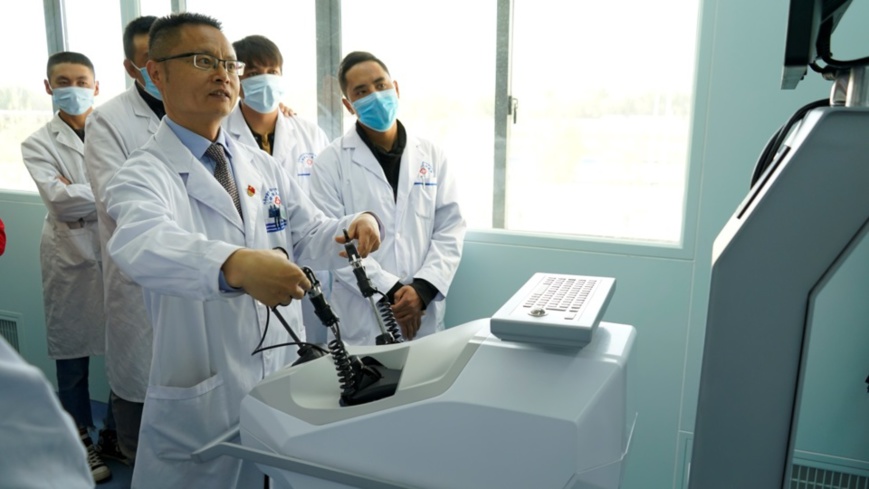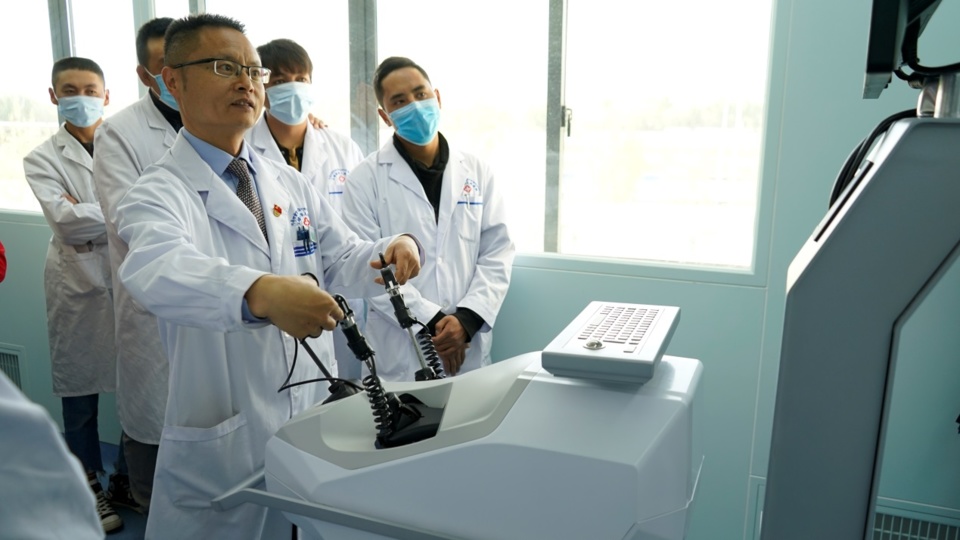By Shen Shaotie, People’s Daily

Guo Weigang, a doctor at Zhongshan Hospital, an affiliated hospital of Fudan University, performs a demonstration surgery at the Shigatse People’s Hospital. (Photo by Shen Shaotie/People’s Daily)
“I planned to see a doctor in Chengdu, but then I heard some medical experts from Guangzhou came to the local hospital. So I came here to treat my arm,” said Hu Yangchun, a man who was under physical therapy for his right arm in the department of physiotherapy and rehabilitation at the People’s Hospital in Nyingchi, southwest China’s Tibet Autonomous Region.
Hu is a teacher at an elementary school in Nyingchi’s Bomi county. His cervical spine and right arm were injured by a debris flow when he walked his students home. Hu couldn’t stretch his right arm straight after it was injured, which made it difficult for him to eat. And he had to use his left hand to write on the blackboard on classes.
After treatment, he is now able to write normally, said Hu, slowly stretching his right arm.
“Air pressure wave therapy equipment has a very good and quick effect on the patients,” said Lhagod, director of the department of physiotherapy and rehabilitation of the People’s Hospital in Nyingchi, disclosing that the equipment was introduced to the hospital by the medical experts from south China’s Guangdong province.
The province has sent batches of medical experts to Tibet since 2015, explained Lhagod, adding that experts from Guangzhou, capital of Guangdong province, have brought earth-shaking changes to his department in the past year.
In June 2015, China launched a medical assistance program for Tibet. Medical teams from 7 provinces and municipalities, including Beijing, Shanghai, and Guangdong have been dispatched by China’s National Health Commission to designated hospitals in Tibet Autonomous Region in batches, to help build up medical capacity of the Tibet People’s Hospital and seven other hospitals.
A total of 659 medical staff had provided assistance to hospitals in Tibet by the time when the fourth batch of medical teams completed their job there.
They brought 847 advanced technological results and experiences, as well as 1,014 new medical technologies to Tibet. At present, the autonomous region is able to independently cure 338 kinds of major diseases, and 1,990 kinds of medium-level diseases can be cured in the region’s prefectures and cities.
At present, the fifth batch of medical teams has been sent to Tibet. Over the past four years, Tibet has witnessed significant progress in its medical services and health sector. The numbers of hospital beds, healthcare technicians, and professional doctors per 1,000 people are close to the national average.
“In the past, our department could only provide some simple conventional physical therapies for rehabilitation. Now, with the help of advanced ultrasonic examination, we can accurately detect diseases of arm and leg,” said Lhagod.
Some experts not only brought advanced modern medical equipment and technologies for treatment to Lhagod’s department, but also helped trained doctors there, attracting a great number of patients to the department. Jiang Li, a medical expert from the rehabilitation department of The Third Affiliated Hospital of Sun Yat-sen University, is one of them.
Shu Daqing is a student of Jiang. Studying anatomy, as well as the theories and practice of ultrasonic wave under the guidance of Jiang, Shu has basically mastered the examination and treatment for joint diseases troubling shoulder joint, ankle joint and joints of other limbs.
Under Jiang’s instruction, Shu pays high attention on scientific research, and is planning to work on medical thesis.
According to an executive of the health department of Nyingchi, 146 pairs of partner assistance have been formed between the medical experts from Guangdong and key local medical staff of Tibet. They have formulated methods to evaluate the teaching, and set quantified targets for the teaching and construction of key departments.
These efforts have helped improve the professional competence of local medical workers and the human resource structure of the medical service and health industry of the region.
Under the help of the assisting medical teams, a medical training base covering all departments has been established in the People’s Hospital in Nyingchi. So far, the base has provided training for more than 1,000 local medical workers.
In the Shigatse People’s Hospital that locates in a city with an altitude of 3,800 meters above sea level, a brand new building is particularly eye-catching. It is a clinical simulation training center aided by Shanghai.
The building is equipped with advanced clinical teaching models and systems including smart simulation system and multimedia-based teaching system. It can be used for various training and exams.
Since 2015, the teams dispatched to Tibet by the medical assistance program have guided 588 local teams and 1,446 local medical workers, and trained 984 key local medical staffs and 1,593 from county-level hospitals, according to Wang Yunting, Party chief and deputy director of Tibet’s health commission.
At present, 120 assisted doctors in the autonomous region are able to perform one or two kinds of new surgeries independently, and 803 were promoted, Wang said.
Besides, assisted hospitals in Tibet have also sent 1,147 local medical workers to the hospitals that paired with them for further study, Wang added.
Hu is a teacher at an elementary school in Nyingchi’s Bomi county. His cervical spine and right arm were injured by a debris flow when he walked his students home. Hu couldn’t stretch his right arm straight after it was injured, which made it difficult for him to eat. And he had to use his left hand to write on the blackboard on classes.
After treatment, he is now able to write normally, said Hu, slowly stretching his right arm.
“Air pressure wave therapy equipment has a very good and quick effect on the patients,” said Lhagod, director of the department of physiotherapy and rehabilitation of the People’s Hospital in Nyingchi, disclosing that the equipment was introduced to the hospital by the medical experts from south China’s Guangdong province.
The province has sent batches of medical experts to Tibet since 2015, explained Lhagod, adding that experts from Guangzhou, capital of Guangdong province, have brought earth-shaking changes to his department in the past year.
In June 2015, China launched a medical assistance program for Tibet. Medical teams from 7 provinces and municipalities, including Beijing, Shanghai, and Guangdong have been dispatched by China’s National Health Commission to designated hospitals in Tibet Autonomous Region in batches, to help build up medical capacity of the Tibet People’s Hospital and seven other hospitals.
A total of 659 medical staff had provided assistance to hospitals in Tibet by the time when the fourth batch of medical teams completed their job there.
They brought 847 advanced technological results and experiences, as well as 1,014 new medical technologies to Tibet. At present, the autonomous region is able to independently cure 338 kinds of major diseases, and 1,990 kinds of medium-level diseases can be cured in the region’s prefectures and cities.
At present, the fifth batch of medical teams has been sent to Tibet. Over the past four years, Tibet has witnessed significant progress in its medical services and health sector. The numbers of hospital beds, healthcare technicians, and professional doctors per 1,000 people are close to the national average.
“In the past, our department could only provide some simple conventional physical therapies for rehabilitation. Now, with the help of advanced ultrasonic examination, we can accurately detect diseases of arm and leg,” said Lhagod.
Some experts not only brought advanced modern medical equipment and technologies for treatment to Lhagod’s department, but also helped trained doctors there, attracting a great number of patients to the department. Jiang Li, a medical expert from the rehabilitation department of The Third Affiliated Hospital of Sun Yat-sen University, is one of them.
Shu Daqing is a student of Jiang. Studying anatomy, as well as the theories and practice of ultrasonic wave under the guidance of Jiang, Shu has basically mastered the examination and treatment for joint diseases troubling shoulder joint, ankle joint and joints of other limbs.
Under Jiang’s instruction, Shu pays high attention on scientific research, and is planning to work on medical thesis.
According to an executive of the health department of Nyingchi, 146 pairs of partner assistance have been formed between the medical experts from Guangdong and key local medical staff of Tibet. They have formulated methods to evaluate the teaching, and set quantified targets for the teaching and construction of key departments.
These efforts have helped improve the professional competence of local medical workers and the human resource structure of the medical service and health industry of the region.
Under the help of the assisting medical teams, a medical training base covering all departments has been established in the People’s Hospital in Nyingchi. So far, the base has provided training for more than 1,000 local medical workers.
In the Shigatse People’s Hospital that locates in a city with an altitude of 3,800 meters above sea level, a brand new building is particularly eye-catching. It is a clinical simulation training center aided by Shanghai.
The building is equipped with advanced clinical teaching models and systems including smart simulation system and multimedia-based teaching system. It can be used for various training and exams.
Since 2015, the teams dispatched to Tibet by the medical assistance program have guided 588 local teams and 1,446 local medical workers, and trained 984 key local medical staffs and 1,593 from county-level hospitals, according to Wang Yunting, Party chief and deputy director of Tibet’s health commission.
At present, 120 assisted doctors in the autonomous region are able to perform one or two kinds of new surgeries independently, and 803 were promoted, Wang said.
Besides, assisted hospitals in Tibet have also sent 1,147 local medical workers to the hospitals that paired with them for further study, Wang added.
 Menu
Menu
 Tibet sees improved structure of medical personnel thanks to medical assistance program
Tibet sees improved structure of medical personnel thanks to medical assistance program
















